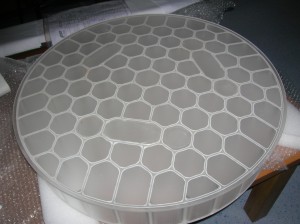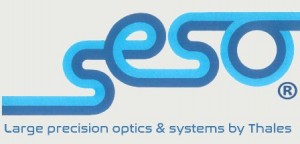Secondary mirror for MRO
 Thales SESO has manufactured (i.e. grinding, polishing and coating) the secondary ULE mirror of the Magdalena Ridge Observatory (MRO). This is a challenging highly off axis convex aspherical mirror.
Thales SESO has manufactured (i.e. grinding, polishing and coating) the secondary ULE mirror of the Magdalena Ridge Observatory (MRO). This is a challenging highly off axis convex aspherical mirror. The main characteristics and specifications of this mirror are:
• Substrate: Lightened ULE structure with Corning fusion process • Size : circular Φ690mm • Shape: hyperbolic Convex with about 50µm asphericity from best fit sphere • Optical quality required: WFE < 40nm RMS for full Clear Aperture • Coating: protected aluminum [/row] [row] One of the main challenges of this mirror was the optical control because we are facing simultaneously different problems: a large mirror, an aspherical surface are, moreover, a convex one. Thales SESO has developed for this mirror a full aperture interferometric bench using a large sized Hindle corrector. Errors due to Hindle corrector itself and WFE distortions induced by the natural gravity were managed and compensated thanks to a specific control iteration process. [/row] [row] [button text=”<< Back to list" link="new-services/ground-based-astronomy/" style="default" size="normal" target="_self" display="inline" icon="no"] [/row]
